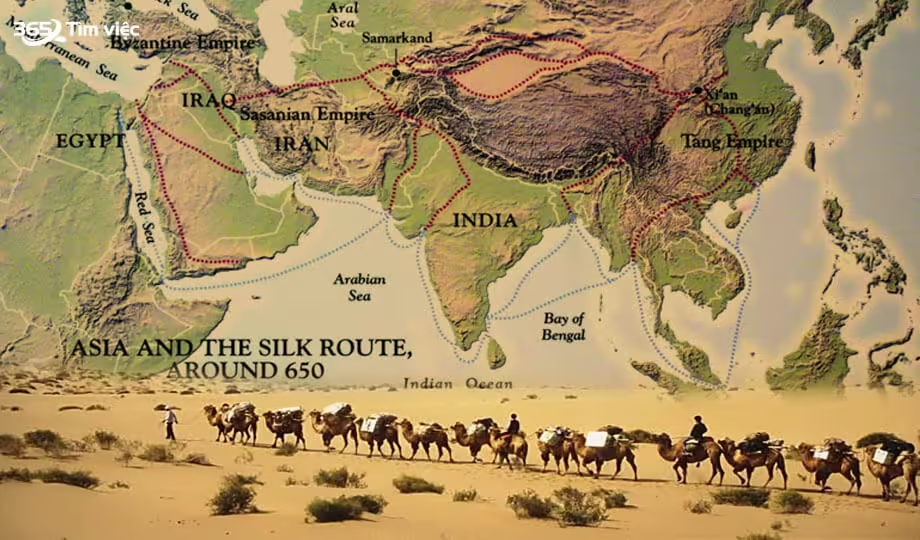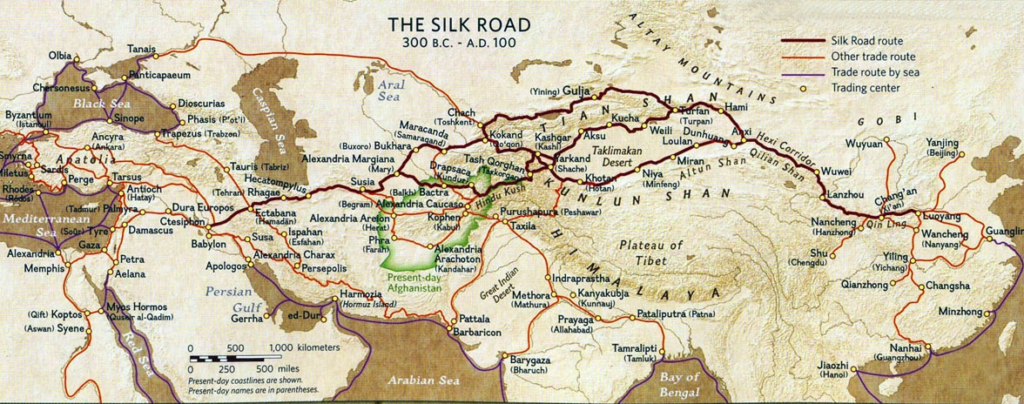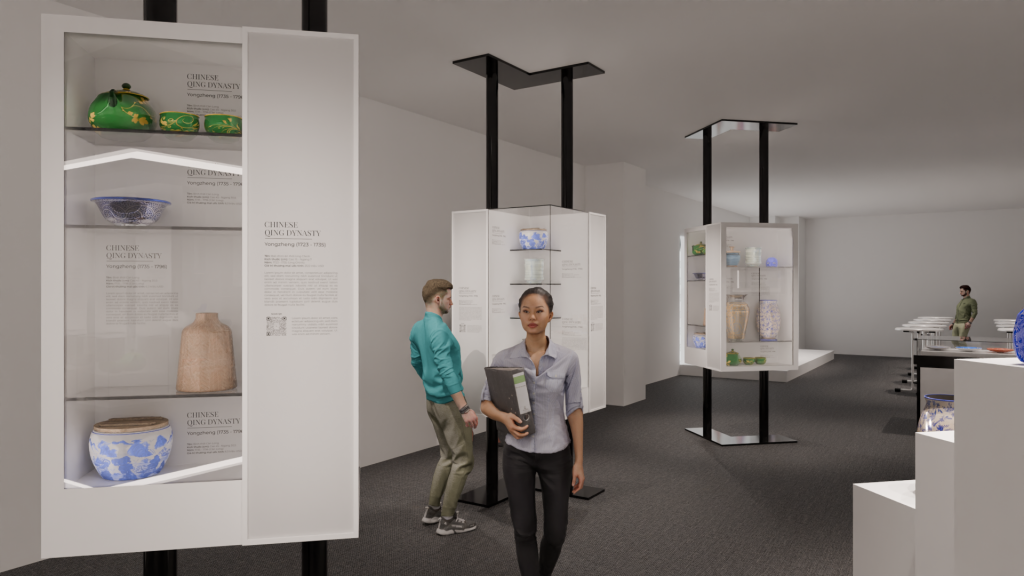From rough clay to the magnificent palaces of great dynasties. Follow Katiart’s to explore “The Journey of Ceramics on the Silk Road: From Clay to Empire.” The journey of ceramics begins in Central Asia, where local kilns started producing the first items. Ceramics from Central Asia appeared from the 7th-9th centuries, often influenced by the techniques and styles of Eastern cultures. Here, local artisans developed unique ceramic techniques, combining elements from China and local regions, creating products that are not only beautiful but also rich in the cultural imprint of the area.
What is Katiart’s Mission? Why should readers know about Katiart’s Gallery?

I. The Silk Road – A Ribbon Connecting the Cultural History of the World
1. Central Asia – The Cradle of Ceramic Art
The Silk Road was not only an ancient trade route but also a grand cultural journey, where ceramics played a crucial role in connecting different civilizations. Originating from the kilns in Central Asia to the palaces in Europe, let’s explore the fascinating journey of ceramics through the countries along the Silk Road.
a. Early Period:
Central Asian ceramics appeared from the 7th-9th centuries, with the first kilns built along the Silk Road. This is where artisans developed unique ceramic techniques, combining elements from China and local regions.
In 751 – The Battle of Talas between the Abbasid Caliphate and the Tang Dynasty was a significant event, promoting the exchange of techniques, including ceramic crafting technology. These techniques were later adopted and developed by Central Asian artisans into artworks rich in regional cultural imprints.
b. Techniques and Styles:
Jade glaze technique – A prominent feature of Central Asian ceramics during this period was the jade glaze, influenced by China but improved by artisans to create products suitable for local tastes and cultural characteristics. The geometric patterns and rich colors from Persian and Islamic cultures created unique and valuable artworks.
2. India – The Wonder of Ceramic Art
When ceramics reached India, it opened a “new era in ceramic art” for the region. In India, ceramics were not only favored for their quality and design but also for their ability to reflect rich cultural exchanges.
a. Cultural Integration:
When Central Asian ceramics arrived in India around the 11th century, Indian artisans adopted and integrated new elements, creating sophisticated products with distinctive Indian cultural patterns.
In 1025 – The development of the Chola Empire and trade with Central Asia brought ceramics into the royal and public life of India, creating sophisticated ceramic products with Hindu cultural imprints.
b. Materials and Techniques:
Indian ceramics used high-quality clay and high-temperature firing techniques, creating durable and beautiful products, especially from the 13th-14th centuries. Ceramic products were used not only for decoration but also in religious ceremonies and daily life.
Cobalt blue glaze – Widely used in India, combined with high-temperature firing techniques, creating products with timeless durability and beauty, used in religious ceremonies and daily life.
3. The Middle East – Crossing the Seas to Conquer Art
Ceramics continued their journey across the seas to the Middle East. Here, ceramic products were not only trade goods but also symbols of prosperity and power.
a. Trade and Exchange:
Around 900, trade between Persia, Arabia, and Central Asia made ceramics a valuable commodity, widely exchanged along the Silk Road. Middle Eastern ceramics, especially from Persia, were famous for their blue and jade green glazes, creating high artistic value products.
b. Biểu Tượng Văn Hóa:
From around the 9th-10th centuries, ceramic vases were used in palaces and mosques, symbolizing wealth and power. The Middle East developed special ceramic glaze techniques like blue and jade green glazes, creating high artistic value products.
Green and blue glazes – Middle Eastern artisans developed unique glaze techniques, giving Middle Eastern ceramics a distinctive beauty with rich colors and intricate patterns, reflecting the wealth and power of dynasties.
c. Pinnacle Achievements Leaving Marks of Ceramic Art:
The oldest earthenware found in the Middle East dates back to around 7000 BCE. Their shapes were modeled after woven baskets.
Source: ivivu.com
The production of construction ceramics, especially colored glazed tiles, appeared in the Middle East around 2000 BCE. Around 500 BCE, churches and palaces in the Middle East were paved with tiles that still impress people today. Following the footsteps of the Arabs, the technique of producing glazed tiles spread to Spain.
4. Europe – Luxury and Power
The export of Chinese porcelain to European countries began quite early, possibly from the sea voyages of Admiral Zheng He (1371-1435). Around the late 15th and early 16th centuries, blue and white underglaze porcelain entered Europe via the sea route around Africa.
a. Cultural Impact:
When ceramics arrived in Europe, starting in the late 15th and early 16th centuries (around 1490-1510), they quickly became symbols of luxury. European countries, especially in courts and palaces, received ceramics with admiration and regarded them as symbols of wealth and power.

In 1602 – The establishment of the Dutch East India Company (VOC) facilitated the import of ceramics from China to Europe, especially blue and white ceramics, highly favored by European nobility.
b. Development of Ceramic Art:
From the 17th century, European artisans learned and improved ceramic techniques from Asia, leading to the development of famous ceramic centers like Meissen in Germany (established in 1710) and Sèvres in France (established in 1740). These centers learned and improved techniques from Asia, developing high artistic value ceramic works, widely used in royalty and nobility. Ceramics were not only decorative items but also widely used in daily life.
5. Southeast Asia – Ethnic Colors Hidden in Every Line
a. Vietnam: Vietnamese ceramics are famous for products from Bat Trang and Chu Dau, with intricate patterns, jade, and blue glazes. From the 14th-15th centuries, these products reflected the sophistication and artistry of the Vietnamese people, becoming cultural symbols of the country.
b. Japan: Japan developed ceramic art with product lines like Imari, Kakiemon, and Satsuma around the 17th century. These products are notable for their colored glaze techniques and complex patterns, considered symbols of tea culture.
c. Korea: Korean ceramics, especially celadon and Buncheong ware, reached their peak from the 10th-14th centuries. Korean ceramic products have distinctive jade green colors and intricate carvings, reflecting the sophistication and high techniques of Korean artisans.
d. China: China is the cradle of ceramics, with famous product lines like blue and white porcelain, jade green glaze, and ceramics from the Tang, Song, Ming, and Qing dynasties. Each period, from the 7th to the 19th centuries, had its characteristics and techniques, creating diversity and richness in ceramic art.
II. Symbols of Cultural Exchange as Global Heritage of Nations
Today, ceramics are not only a part of history but also symbols of global cultural connection and exchange. From Central Asia to India, the Middle East, Europe, and Southeast Asia, ceramics have left indelible marks in the history of art and culture. Ceramics are evidence of cultural exchange, development, and improvement of crafting techniques over periods, contributing to unique artworks.
Learn more about the knowledge provided by Katiart’s Gallery?
III. Conclusion
The Silk Road is a long journey to achieve the pinnacle of ceramic art in culture and life. And nothing is more wonderful than admiring the “treasures of time” at the Essence of Ceramics Exhibition. At Katiart’s Gallery, we bring a unique art exhibition space, not only preserving the historical culture of ceramics but also connecting with modern technology to provide an excellent experience for viewers.
Museums & art galleries around the world are places to preserve and display precious Chinese antiques:
- Katiart’s Gallery – Vietnam
- National Palace Museum – Taipei
- The Metropolitan Museum of Art – New York
- Victoria and Albert Museum (V&A) – London
- Musée Guimet – Paris

Katiart’s Gallery not only honors the value of each artifact but also evokes historical stories and human mysteries, inspiring future generations, opening the door to the wonderful world of knowledge and creativity.
The exhibition “Katiart’s – The Essence of Ceramics” is a journey through history, honoring the essence of traditional craftsmanship, from ancient times to the modern era. The displayed works not only carry material value but also embody the culture and soul of humanity through the ages. The exhibition is not only a place to admire the beauty of creations but also a bridge to the past, preserving the mysteries and exquisite techniques passed down through generations.
Related Articles:

Pingback: THE PAINTING ON CLAY NAMED ANCIENT CERAMICS - Katiart's : Leading Platform for Art Enthusiasts | 2023